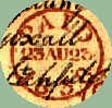

This letter also appears on the Victorian Web
 At the time John Bing of London wrote his letter to Joseph Allington in Yoxall, there were two branches of the post office to deal with mail in
London. The General post dealt with letters to and from all parts of the country,
as a kind of clearing house. For example a letter going from Leeds in Yorkshire,
addressed to Maidstone in Kent, had to go through the General Post, through
London.
At the time John Bing of London wrote his letter to Joseph Allington in Yoxall, there were two branches of the post office to deal with mail in
London. The General post dealt with letters to and from all parts of the country,
as a kind of clearing house. For example a letter going from Leeds in Yorkshire,
addressed to Maidstone in Kent, had to go through the General Post, through
London.
Letters originating from, or to be delivered within the London area were dealt with through the office of the London Twopenny Post. This began life as the London Penny Post, but increased costs resulted in a name change. The Twopenny Post was a branch of the General post but had separate offices, uniforms, staff, charges, accounting and of course, postmarks. This variety is one of the reasons why British postal markings can make such an interesting collection.
This letter bears five different postal markings:
 |
1. Manuscript 2d. This was written on to show that the charge for lodging the letter within the area of the Twopenny Post had been paid. |  |
2. P9 — the charge mark. This was the amount that it was going to cost to send the letter from London to Staffordshire, through the General Post. At this time, the cost of sending a letter was based on the distance it had to travel, the number of pieces of paper (1 if it had no enclosures), and ultimately the weight. In 1838 the mileage from London to Litchfield was 119, and the rate for a distance between 80 and 120 miles was 9d (nine pence). This pre-paid sum of 9d would have to be accounted for in the London Twopenny Post books. |
 |
3. The red octagonal
transfer stamp. This type of stamp was introduced in 1838, was applied
at applied at the Chief Office of the London Twopenny Post, showing the
time and date the letter was transferred to the General Post — 8 o'clock
at night on August 23rd, 1838. From 1837 the 7 oclock night delivery was
replaced with two deliveries, one at 6 oclock and one at 8 oclock.
The letter inside is dated August 20th,(a Monday) but the first postmark is clearly the 23rd,(Thursday). Perhaps the information about Dr. Blick's death delayed the sending of the letter. |

| 4. The red circular DATE stamp: applied at the General Post inland section PAID 23 AU 23 1838 when it was received for onward transmission to Litchfield. |
|
|
5. The red circular stamp GP PAID: applied at the Chief Office of the General Post, to confirm that the cost of postage had been prepaid. |
Many people have said to me that they did not know letters could be sent before postage stamps were invented. This was far from the truth, as these statistics show:
To see how a letter would have been written and posted at this time, follow
this link
If you are interested in how letters were sent before the introduction of the
Penny Black postage stamp, follow
this link to a New Zealand-based site for the story 'Before the Penny Black'.
| Home Page | Letters index page |
Last modified |